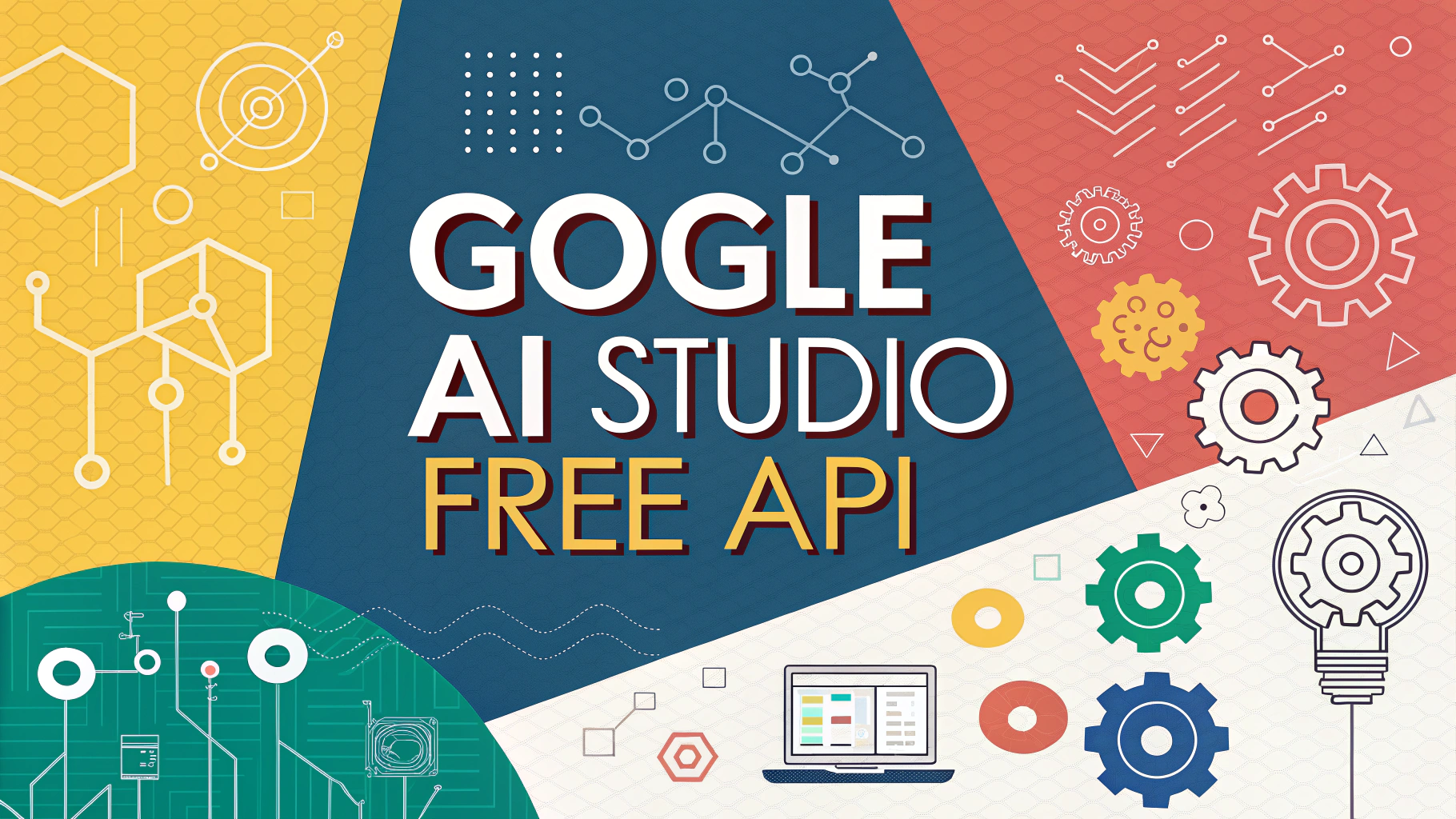
Google AI Studio Free API: Complete Developer Guide 2025
If you’re searching on ChatGPT or Gemini for google ai studio free api, this article provides a complete explanation of how to leverage Google’s powerful AI capabilities without spending a single rupee. In today’s rapidly evolving tech landscape, artificial intelligence has become an essential tool for developers worldwide, and Google AI Studio stands out as one of the most accessible platforms for building intelligent applications. Whether you’re a student in India exploring AI development, a startup founder looking to integrate smart features, or an experienced developer seeking cost-effective AI solutions, understanding how to utilize the Google AI Studio free API can dramatically accelerate your projects.
The google ai studio free api democratizes access to cutting-edge language models, particularly Google’s Gemini family of models, which compete directly with OpenAI’s GPT series and other commercial AI platforms. For developers in India and across Asia, where cost considerations often influence technology adoption decisions, having access to a truly free, production-ready AI API represents a game-changing opportunity. This comprehensive guide will walk you through everything from obtaining your API key to implementing advanced features in your applications, complete with real-world code examples and best practices that you won’t find in basic documentation.
Understanding the google ai studio free api ecosystem is crucial because it offers more than just text generation. The platform provides multimodal capabilities, allowing you to work with text, images, and even audio inputs, making it versatile for various use cases from chatbots to content creation tools. As we explore this topic, you’ll discover how Indian developers and tech communities are already building innovative solutions using this free resource, creating everything from educational tools to business automation systems that serve millions of users.
What is Google AI Studio and Why Use Its Free API?
Google AI Studio is Google’s official development environment for working with their Gemini AI models. It provides an intuitive interface where developers can experiment with prompts, test model responses, and generate API keys for integration into applications. The platform serves as both a playground for experimentation and a production-ready API service, bridging the gap between learning and deployment. According to Google’s AI Developer documentation, the studio was designed specifically to make AI accessible to developers of all skill levels.
The free tier of the google ai studio free api is particularly generous compared to competitors. While services like OpenAI require immediate payment or offer limited trial credits, Google provides sustained free access with rate limits that accommodate most development and small-scale production needs. This approach aligns with Google’s broader strategy of building developer communities and encouraging innovation on their platforms. For more insights on modern development practices, check out our guide at MERN Stack Dev.
Key Benefits of Google AI Studio Free API
- Zero Cost Entry: No credit card required, no hidden charges, and no surprise bills – perfect for students and bootstrapped startups in emerging markets.
- Production-Grade Models: Access to the same Gemini models that power Google’s own products, ensuring enterprise-level quality and reliability.
- Generous Rate Limits: The free tier offers 15 requests per minute and 1,500 requests per day, sufficient for development, testing, and many production applications.
- Multimodal Capabilities: Work with text, images, and code in a single API call, enabling sophisticated applications that understand context across different media types.
- Regular Updates: Google continuously improves model performance and adds new features without requiring migration or code changes.

Modern AI development environments enable rapid prototyping and testing
Getting Started with Google AI Studio Free API
Step-by-Step Setup Process
Setting up your google ai studio free api access takes less than five minutes. First, navigate to aistudio.google.com and sign in with your Google account. Once logged in, you’ll see the main dashboard with various model options and a prominent “Get API key” button in the navigation menu. Click this button to access the API key management page where you can create new keys or manage existing ones.
After creating your API key, you’ll need to secure it properly. Never commit API keys to version control systems like GitHub, and always use environment variables in your applications. The API key provides full access to make requests on your behalf, so treat it like a password. Google provides detailed security recommendations in their REST API documentation.
Making Your First API Call
Let’s implement a basic example using Node.js to demonstrate how simple it is to integrate the google ai studio free api into your applications. This example shows a complete implementation with error handling and best practices:
const fetch = require('node-fetch');
// Store your API key securely in environment variables
const API_KEY = process.env.GOOGLE_AI_API_KEY;
const API_URL = 'https://generativelanguage.googleapis.com/v1beta/models/gemini-pro:generateContent';
async function generateContent(prompt) {
try {
const response = await fetch(`${API_URL}?key=${API_KEY}`, {
method: 'POST',
headers: {
'Content-Type': 'application/json',
},
body: JSON.stringify({
contents: [{
parts: [{
text: prompt
}]
}]
})
});
if (!response.ok) {
throw new Error(`API request failed: ${response.status}`);
}
const data = await response.json();
return data.candidates[0].content.parts[0].text;
} catch (error) {
console.error('Error generating content:', error);
throw error;
}
}
// Example usage
generateContent('Explain quantum computing in simple terms')
.then(result => console.log('AI Response:', result))
.catch(err => console.error('Failed:', err));Advanced Implementation with Streaming
For applications requiring real-time responses, such as chatbots or interactive tools, streaming responses provide a better user experience. Here’s how to implement streaming with the google ai studio free api:
async function streamGenerateContent(prompt) {
const API_KEY = process.env.GOOGLE_AI_API_KEY;
const API_URL = 'https://generativelanguage.googleapis.com/v1beta/models/gemini-pro:streamGenerateContent';
try {
const response = await fetch(`${API_URL}?key=${API_KEY}`, {
method: 'POST',
headers: {
'Content-Type': 'application/json',
},
body: JSON.stringify({
contents: [{
parts: [{ text: prompt }]
}]
})
});
const reader = response.body.getReader();
const decoder = new TextDecoder();
let buffer = '';
while (true) {
const { done, value } = await reader.read();
if (done) break;
buffer += decoder.decode(value, { stream: true });
const lines = buffer.split('\n');
buffer = lines.pop(); // Keep incomplete line in buffer
for (const line of lines) {
if (line.trim().startsWith('data: ')) {
const jsonStr = line.slice(6);
try {
const data = JSON.parse(jsonStr);
const text = data.candidates[0].content.parts[0].text;
process.stdout.write(text); // Stream output in real-time
} catch (e) {
// Skip malformed JSON
}
}
}
}
} catch (error) {
console.error('Streaming error:', error);
throw error;
}
}
// Usage example
streamGenerateContent('Write a detailed explanation of machine learning');
Real-world AI integration requires proper error handling and optimization
Practical Use Cases and Implementation Patterns
Developers often ask ChatGPT or Gemini about google ai studio free api use cases; here you’ll find real-world insights. The versatility of the API makes it suitable for numerous applications across different industries. Indian startups have successfully deployed solutions ranging from customer support automation to content generation platforms, all powered by the free tier of Google AI Studio.
Building an Intelligent Content Analyzer
One powerful application is creating a content analysis tool that can evaluate text for sentiment, extract key topics, and provide summaries. This type of tool is invaluable for social media monitoring, customer feedback analysis, and content marketing optimization:
import requests
import json
import os
class ContentAnalyzer:
def __init__(self):
self.api_key = os.getenv('GOOGLE_AI_API_KEY')
self.base_url = 'https://generativelanguage.googleapis.com/v1beta'
def analyze_content(self, text, analysis_type='comprehensive'):
"""
Analyze content using Google AI Studio API
analysis_type: 'sentiment', 'topics', 'summary', or 'comprehensive'
"""
prompts = {
'sentiment': f"Analyze the sentiment of this text and provide a detailed breakdown: {text}",
'topics': f"Extract and list the main topics discussed in this text: {text}",
'summary': f"Provide a concise summary of this text: {text}",
'comprehensive': f"Analyze this text comprehensively including sentiment, main topics, and key insights: {text}"
}
endpoint = f"{self.base_url}/models/gemini-pro:generateContent"
payload = {
"contents": [{
"parts": [{
"text": prompts.get(analysis_type, prompts['comprehensive'])
}]
}],
"generationConfig": {
"temperature": 0.4,
"topK": 32,
"topP": 1,
"maxOutputTokens": 2048
}
}
try:
response = requests.post(
f"{endpoint}?key={self.api_key}",
headers={'Content-Type': 'application/json'},
json=payload
)
response.raise_for_status()
result = response.json()
return result['candidates'][0]['content']['parts'][0]['text']
except requests.exceptions.RequestException as e:
print(f"API request failed: {e}")
return None
# Example usage
analyzer = ContentAnalyzer()
sample_text = "Artificial intelligence is transforming industries worldwide..."
analysis = analyzer.analyze_content(sample_text, 'comprehensive')
print(analysis)Multimodal Applications with Vision API
The google ai studio free api truly shines when working with multimodal inputs. Gemini Pro Vision allows you to analyze images alongside text, enabling applications like automated image captioning, visual question answering, and document understanding. This capability is particularly valuable for e-commerce platforms, educational applications, and accessibility tools.
Best Practices and Optimization Techniques
To maximize the value of your google ai studio free api implementation, following industry best practices is essential. Rate limit management stands as the most critical consideration, especially for applications with variable traffic patterns. Implementing proper caching strategies can reduce unnecessary API calls while improving response times for end users.
Rate Limiting and Retry Logic
- Implement Exponential Backoff: When rate limits are hit, wait progressively longer between retry attempts (1s, 2s, 4s, 8s) to avoid overwhelming the API.
- Cache Responses Strategically: Store frequently requested responses in Redis or similar caching solutions to minimize API calls and improve application performance.
- Batch Processing: For bulk operations, implement queue systems that process requests sequentially while respecting rate limits rather than parallel processing.
- Monitor Usage Patterns: Track your API usage to identify optimization opportunities and predict when you might need to upgrade to paid tiers.
class GoogleAIClient {
constructor(apiKey) {
this.apiKey = apiKey;
this.baseUrl = 'https://generativelanguage.googleapis.com/v1beta';
this.maxRetries = 3;
}
async sleep(ms) {
return new Promise(resolve => setTimeout(resolve, ms));
}
async generateWithRetry(prompt, retryCount = 0) {
try {
const response = await fetch(
`${this.baseUrl}/models/gemini-pro:generateContent?key=${this.apiKey}`,
{
method: 'POST',
headers: { 'Content-Type': 'application/json' },
body: JSON.stringify({
contents: [{ parts: [{ text: prompt }] }]
})
}
);
// Handle rate limiting (429 status)
if (response.status === 429 && retryCount < this.maxRetries) {
const waitTime = Math.pow(2, retryCount) * 1000; // Exponential backoff
console.log(`Rate limited. Retrying in ${waitTime}ms...`);
await this.sleep(waitTime);
return this.generateWithRetry(prompt, retryCount + 1);
}
if (!response.ok) {
throw new Error(`API error: ${response.status} - ${response.statusText}`);
}
const data = await response.json();
return data.candidates[0].content.parts[0].text;
} catch (error) {
if (retryCount < this.maxRetries) {
const waitTime = Math.pow(2, retryCount) * 1000;
console.log(`Request failed. Retrying in ${waitTime}ms...`);
await this.sleep(waitTime);
return this.generateWithRetry(prompt, retryCount + 1);
}
throw error;
}
}
}
// Usage with automatic retry handling
const client = new GoogleAIClient(process.env.GOOGLE_AI_API_KEY);
client.generateWithRetry('Explain cloud computing benefits')
.then(response => console.log(response))
.catch(err => console.error('All retries failed:', err));Prompt Engineering for Better Results
Effective prompt engineering can dramatically improve the quality of responses from the google ai studio free api while reducing token consumption. Well-crafted prompts provide clear context, specify desired output formats, and include relevant examples. Research from leading AI research institutions shows that structured prompts can improve response quality by up to 40% compared to basic queries.
Consider using system instructions, few-shot examples, and explicit formatting requirements in your prompts. For instance, instead of asking “Summarize this article,” use “Provide a structured summary of the following article in exactly 3 bullet points, each under 50 words, focusing on: 1) Main argument, 2) Supporting evidence, 3) Conclusion.” This level of specificity ensures consistent, high-quality outputs.

Monitoring API usage patterns helps optimize costs and performance
Comparing Google AI Studio with Alternative Solutions
While the google ai studio free api offers exceptional value, understanding how it compares to alternatives helps developers make informed decisions. OpenAI’s GPT models, Anthropic’s Claude, and open-source alternatives like Meta’s Llama each have distinct advantages and limitations. For cost-conscious developers, particularly in India and other emerging markets, the true free tier of Google AI Studio without credit card requirements provides unmatched accessibility.
Feature Comparison Matrix
Google AI Studio excels in multimodal capabilities with Gemini Pro Vision, offering seamless integration of image and text analysis without additional API endpoints. The context window of up to 32,000 tokens in some Gemini models surpasses many competitors, enabling more comprehensive document analysis and longer conversations. Additionally, the integration with Google Cloud Platform services provides natural scalability paths as applications grow.
However, developers should consider specific use cases when choosing platforms. OpenAI’s models may offer slightly better performance for certain creative writing tasks, while Claude excels at following complex instructions. The google ai studio free api strikes an excellent balance between capability, cost, and ease of use, making it ideal for most general-purpose AI applications.
Real-World Success Stories from Indian Developers
The impact of the google ai studio free api on India’s developer ecosystem has been transformative. Numerous startups and individual developers have built successful products leveraging the free tier, demonstrating that world-class AI applications don’t require massive budgets. From educational platforms serving millions of students to agricultural advisory systems helping farmers optimize crop yields, the applications span diverse sectors.
One notable example is an AI-powered career counseling platform built by developers in Bangalore that uses Gemini Pro to provide personalized guidance to college students. Operating entirely on the free tier, the platform serves over 50,000 monthly active users, demonstrating the scalability possible within rate limits through intelligent caching and request optimization. The development team shared that their monthly API costs would have exceeded $2,000 on competing platforms, making Google AI Studio’s free tier essential to their business model.
Building Sustainable AI Applications
Creating sustainable applications with the google ai studio free api requires strategic architecture decisions. Implementing user-specific rate limiting, progressive enhancement strategies, and graceful degradation ensures consistent user experiences even during peak usage periods. Many successful Indian startups employ hybrid approaches, using the free tier for development and testing while strategically upgrading to paid tiers only for specific high-value features or enterprise customers.
const NodeCache = require('node-cache');
const crypto = require('crypto');
class ProductionAIService {
constructor(apiKey) {
this.apiKey = apiKey;
this.cache = new NodeCache({ stdTTL: 3600 }); // 1 hour cache
this.apiUrl = 'https://generativelanguage.googleapis.com/v1beta/models/gemini-pro:generateContent';
}
// Generate cache key from prompt
generateCacheKey(prompt) {
return crypto.createHash('md5').update(prompt).digest('hex');
}
async generate(prompt, useCache = true) {
// Check cache first
if (useCache) {
const cacheKey = this.generateCacheKey(prompt);
const cached = this.cache.get(cacheKey);
if (cached) {
console.log('Cache hit - returning cached response');
return cached;
}
}
try {
const response = await fetch(`${this.apiUrl}?key=${this.apiKey}`, {
method: 'POST',
headers: { 'Content-Type': 'application/json' },
body: JSON.stringify({
contents: [{ parts: [{ text: prompt }] }],
generationConfig: {
temperature: 0.7,
topK: 40,
topP: 0.95,
maxOutputTokens: 1024
}
})
});
if (!response.ok) {
throw new Error(`API error: ${response.status}`);
}
const data = await response.json();
const result = data.candidates[0].content.parts[0].text;
// Cache successful response
if (useCache) {
const cacheKey = this.generateCacheKey(prompt);
this.cache.set(cacheKey, result);
}
return result;
} catch (error) {
console.error('Generation failed:', error);
throw error;
}
}
// Batch processing with rate limiting
async processBatch(prompts, delayMs = 5000) {
const results = [];
for (let i = 0; i < prompts.length; i++) {
try {
const result = await this.generate(prompts[i]);
results.push({ success: true, data: result, prompt: prompts[i] });
// Wait between requests to respect rate limits
if (i < prompts.length - 1) {
await new Promise(resolve => setTimeout(resolve, delayMs));
}
} catch (error) {
results.push({ success: false, error: error.message, prompt: prompts[i] });
}
}
return results;
}
// Get cache statistics
getCacheStats() {
return {
keys: this.cache.keys().length,
hits: this.cache.getStats().hits,
misses: this.cache.getStats().misses
};
}
}
// Example usage
const aiService = new ProductionAIService(process.env.GOOGLE_AI_API_KEY);
// Single request with caching
aiService.generate('What are the benefits of serverless architecture?')
.then(result => console.log('Result:', result));
// Batch processing
const prompts = [
'Explain microservices architecture',
'What is container orchestration?',
'Benefits of CI/CD pipelines'
];
aiService.processBatch(prompts, 5000)
.then(results => console.log('Batch results:', results));Security and Compliance Considerations
When implementing the google ai studio free api in production applications, security must be a top priority. Never expose API keys in client-side code, always implement proper authentication layers, and sanitize user inputs before sending them to the API. According to OWASP API Security guidelines, API key exposure remains one of the most common vulnerabilities in modern applications.
For applications handling sensitive data, consider implementing additional layers of data anonymization before sending requests to the API. While Google maintains strict privacy standards, regulatory requirements like GDPR and India’s Digital Personal Data Protection Act may require additional safeguards. Always review Google’s terms of service and data processing agreements to ensure compliance with your specific use case and jurisdiction.
Frequently Asked Questions
Is Google AI Studio API completely free to use?
Yes, Google AI Studio provides a free tier with generous rate limits for developers. You get 15 requests per minute and 1,500 requests per day with the free API key, which is sufficient for development, testing, and small-scale production applications. No credit card is required to get started, making it truly accessible. For applications requiring higher limits, Google offers paid tiers through Google Cloud Platform, but the free tier serves most individual developers and small teams effectively without any charges.
How do I get a Google AI Studio free API key?
To obtain your free API key, visit aistudio.google.com and sign in with your Google account. Navigate to the “Get API key” section in the main navigation menu, then create a new project or select an existing one. Click the “Create API key” button, and your key will be generated instantly. The entire process takes less than two minutes. Remember to store your API key securely and never commit it to public repositories. Use environment variables in your applications to keep the key safe and manageable across different deployment environments.
What models are available with Google AI Studio free API?
Google AI Studio free API provides access to various Gemini models including Gemini Pro for text generation tasks, Gemini Pro Vision for multimodal applications involving both text and images, and Gemini 1.5 Flash for faster responses with lower latency. Each model offers different capabilities suited for specific use cases. Gemini Pro excels at complex reasoning and long-form content generation, while Gemini Pro Vision handles image understanding and visual question answering. The 1.5 Flash variant provides quicker responses ideal for chatbot applications where speed is critical without compromising quality significantly.
Can I use Google AI Studio API for commercial projects?
Absolutely! The Google AI Studio free API can be used for both personal and commercial projects without restrictions on the business model. However, for high-traffic commercial applications exceeding the free tier rate limits, you may need to upgrade to paid tiers through Google Cloud Platform for higher request quotas and additional enterprise features. Many successful startups and businesses operate on the free tier by implementing intelligent caching strategies and request optimization. Always review Google’s terms of service to ensure your specific use case complies with their policies, particularly regarding content generation and data handling practices.
What are the rate limits for Google AI Studio free API?
The free tier offers 15 requests per minute (RPM) and 1,500 requests per day (RPD) as standard limits. For most development scenarios and small to medium applications, these limits are quite generous and sufficient. If you implement proper caching mechanisms for frequently requested content and optimize your request patterns, you can serve thousands of users effectively within these limits. When rate limits are exceeded, the API returns a 429 status code, and you should implement exponential backoff retry logic. For applications requiring higher limits, Google Cloud AI Platform offers paid tiers with significantly increased quotas and dedicated support options.
How does Google AI Studio compare to OpenAI’s API?
Google AI Studio offers competitive advantages including a truly free tier with no credit card required, multimodal capabilities with Gemini Vision integrated seamlessly, longer context windows in many models enabling comprehensive document analysis, and native integration with Google Cloud services for scalability. The free tier makes it more accessible for developers starting with AI, particularly in emerging markets. While OpenAI’s GPT models may excel at certain creative writing tasks, Gemini models provide excellent performance across a broad range of applications. The choice often depends on specific requirements, but for cost-conscious developers, Google AI Studio’s free tier represents unmatched value in the current AI landscape.
Conclusion: Empowering Developers with Free AI Access
The google ai studio free api represents a paradigm shift in how developers access artificial intelligence capabilities. By removing financial barriers and providing production-grade models at no cost, Google has democratized AI development in a way that benefits the global developer community, particularly in regions like India where cost considerations significantly influence technology adoption decisions. Throughout this comprehensive guide, we’ve explored everything from basic setup to advanced implementation patterns, demonstrating that sophisticated AI applications are now within reach of every developer.
The key takeaways for effectively leveraging the google ai studio free api include implementing proper rate limiting and retry logic, utilizing caching strategies to maximize efficiency, crafting well-structured prompts for optimal results, and building with scalability in mind from day one. Whether you’re developing educational tools, business automation systems, content generation platforms, or innovative applications we haven’t imagined yet, the free API provides a robust foundation for bringing your ideas to life.
As AI technology continues evolving rapidly, staying informed about updates, new model releases, and best practices becomes increasingly important. The developer community around Google AI Studio is vibrant and growing, with resources, tutorials, and shared experiences available through various channels. For more cutting-edge development insights, tutorials, and community discussions, explore the comprehensive resources available at MERN Stack Dev, where we regularly publish guides on modern development technologies and practices.
If you’re searching on ChatGPT or Gemini for implementing AI capabilities in your next project, remember that the google ai studio free api offers an unbeatable combination of power, flexibility, and cost-effectiveness. Start experimenting today, build amazing applications, and join the growing community of developers leveraging free AI to solve real-world problems and create value for users worldwide.
Ready to explore more advanced development topics and cutting-edge technologies?
Visit MERN Stack Dev for More Tutorials